| "To Conquer the Mountain, Photographers and the Jewish National Fund (Keren Kayemeth Le Israel)," in: Keren Kayemeth and Photography, Photographs from the Blue Box 1903-2003, Gadi Dagon (ed.), 2003 (text for exhibition catalogue) | | | | Abstract | | | At the end of 1933, Leo Herman, general secretary of the United Israel Appeal, went to Germany to seek a highly reputable photographer to work for the national institutions in the service of Zionist propaganda aims. On this mission Herman represented most of the national institutions, among them the Jewish National Fund (JNF), which used the photographic image to market the Zionist idea [1]. “He tried to find the kind of photographer he had been seeking for years,” since “ Palestine was desperate for a top quality documentary photographer” (20.04.1934). Following Nachman Shifrin’s (owner of the PPH Press Photo-Ltd. Agency) application to the funds, Herman approached Zoltan Kluger, one of the leading Jewish photographers working in Germany. Natan Bistritsky, from the publicity department of the Jewish National Fund who in August 1933 travelled to the 18th Zionist congress in Prague, also took advantage of the opportunity and passed through Berlin to meet with Zoltan Kluger, out of a concern “to publicize the National- Israeli enterprise” (6.8.1933). In order to persuade Kluger and Shifrin to immigrate to Eretz-Israel Herman told them: “[…] what glorious opportunities they could look forward to in Palestine with the promised support of the institutions…” (25.04.1934).
The propaganda department of The Jewish National Fund was established in the 1920s in order to document and publicize the commencement of the settlement and conquest of the land in Eretz-Israel. It operated as a central propaganda tool to enlist worldwide public opinion in favour of the Zionist idea (especially in light of the uprising of the Palestinian resistance in 1920, 1921, 1929, 1936-1939), and, to a large extent, with the aim of bringing the Jewish Diaspora closer to Zionist activities and the need to raise money. Over the years, the department built a large and comprehensive archive of photographs, which reflected the Zionist spirit and the strategies outlined by the propaganda departments. First, construction of the image of the new Jew in the new homeland - strong, happy and always in the momentum of work. The difficulties of work and the hard conditions of life in the country are not apparent. Unlike the Diaspora Jew, the new Jew does productive work in harmony with the Zionist idea. Secondly, the propaganda departments sought to establish moral justification for Jewish settlement in Eretz Israel. Thus, they increasingly portrayed the country before the Zionist enterprise as a desolate place, neglected and abandoned, by completely ignoring the local Palestinian and non-Jewish population, and showing the [so called] positive change– through western eyes – that started with the Zionist settlement. Thirdly, the institutions sought to emphasize the benefits for the Palestinian population, shown as backwards and retarded, created by the Zionist settlement, portrayed as the bearer of modernization (Sela, Photography in Palestine in 1930s&1940s, 2000).
The appearance of the photographs suited these messages: most of the photographs are constructed “correctly,” for example, in terms of composition, and were nice-looking. The subjects chosen to be photographed were repeated over and over: proud soldiers (portraits or marching), celebrations (circle motif), joyful workers at work or on their way to work, cultivating the soil with modern and progressive methods, watchtowers as symbols of the new settlements defending themselves, and more. The photographs presented a picture of an ideal world and avoided harsh personal and collective descriptions, conflicts, dealing with moral problems or uncomplimentary images from the social and economic margins. These photographs became an integral part of the image campaign, the marketing and advertising of Zionist propaganda, and were widely distributed – at exhibitions, as postcards, in newspapers, at lectures, in brochures, on stamps, posters and in cinema (Ibid).
The personnel of the national institutions’ propaganda departments – the Jewish National Fund, United Israel Appeal and the Jewish Agency – already in the early stages of their activities understood the function of the photograph as a tool of mass media, and the new medium’s power and ability as an agent for the conveyance of visual images. They internalized the accepted mood of the period, and like Russia, the United States, and Germany, used photography and other visual arts in their marketing and publicity campaigns. “When we wish to have extensive publicity - we need to consider the spirit of the times. The present period demands material that is more for observation than for thought […]. Take for instance, Soviet Russia, in the beginning. There they would express every possible word and action with illustrations or photographs that spoke to the heart of the people without the need for thought and so too must we – we must be prepared with material that will suit people who are needed from every walk of life” (unsigned letter to Natan Bitritsky, 12.11.29) They occupied themselves with constructing a unified and controlled Zionist terminology that greatly influenced the development of a secular, enlisted Israeli society and culture that deserves a fundamental critical examination . Nevertheless, it’s important to emphasize that these were people of vision with a broad worldview, rich culture and charismatic personalities. They conducted a dialogue with corresponding photography trends in the world and made a significant contribution to the flourishing of Jewish photography in the country, then at the beginning of its path.
In this essay a central place is dedicated to the activities of the photographers who worked for the Jewish National fund: their biography, their connection with the Jewish National Fund, their professional path, their worldview and more. In continuation of the book Photography in Palestine/Eretz-Israel in the 1930s and 1940s in this essay I wish to read the National Jewish Fund archive of photographs by discussing the photographers that worked with it. Until the establishment of the State of Israel, the central photographers who worked with the Jewish National Fund were Shmuel Josef Shweig, Avraham Milevsky, Lazar Donner, Zoltan Kluger, Yaakov Rosner and Tim (Nachum) Gidal. From the founding of the State of Israel and up until the Yom Kippur War (1973), the main photographers of the Jewish National Fund were – Fred Chasnick, Werner Braun, Alex Streizmeister and David Harris.
For the full and detailed text on the activities of the Jewish National Fund in the field of photography, and the photographers, see the catalogue The Jewish National Fund Photographs, Pictures from The Blue Box 1903-2003, April 2003. | | | | Notes | | | 1. The publicity departments of the different national institutions co-operated closely on the subject of “propaganda in pictures”: determining policy, contact with the photographers, fees, purchase of negatives, exchange of photographs, duplicates and the like, as described further on.
| | | | | |
| | | | 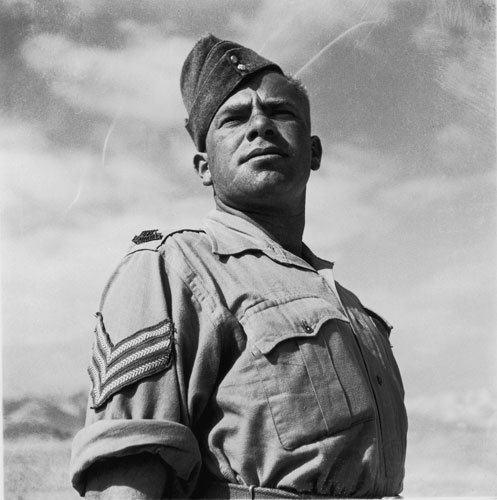 | | Zoltan Kluger, Jewish Soldier, 1941, JNF | | | 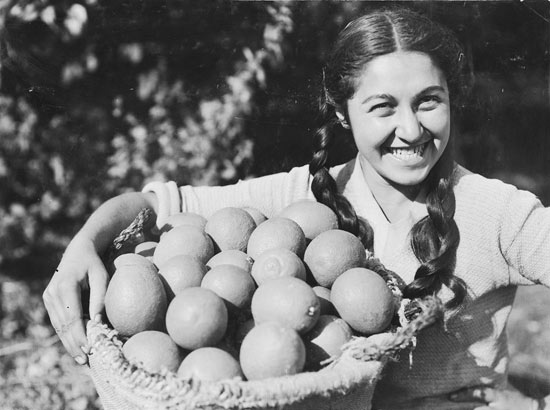 | | Josef Schweig, Young Woman with a Basket of Oranges, 1935, JNF | | | 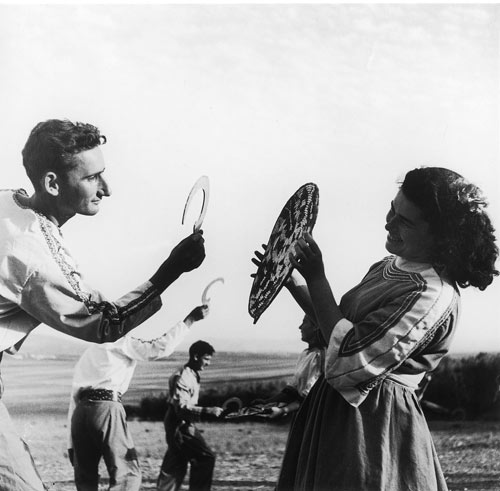 | | Zoltan Kluger, 25th Anniversary to Gannegar, reapers’ dance, 1947, JNF | | | 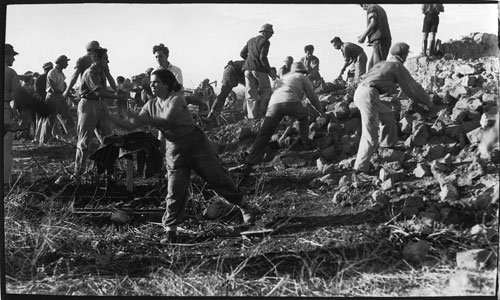 | | Avraham Malavsky, Settling day – joint effort, Kfar- Rupin, 1938, JNF | | | 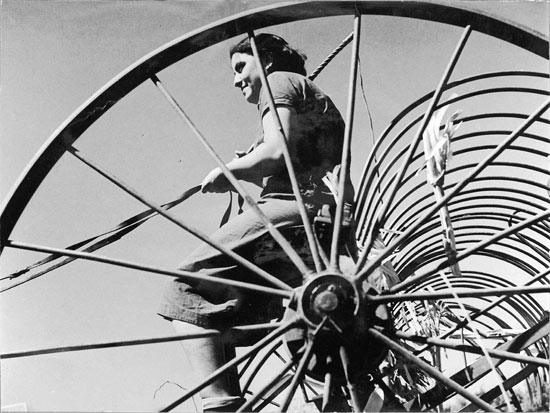 | | Zoltan Kluger, Women Preparing to replace Recruits, 1940, JNF | | |
|
|
| |
|
|
|